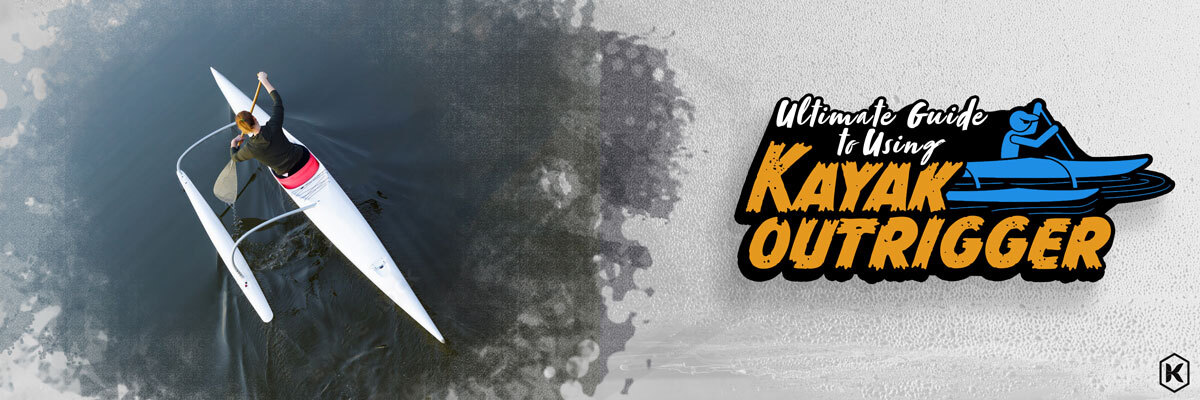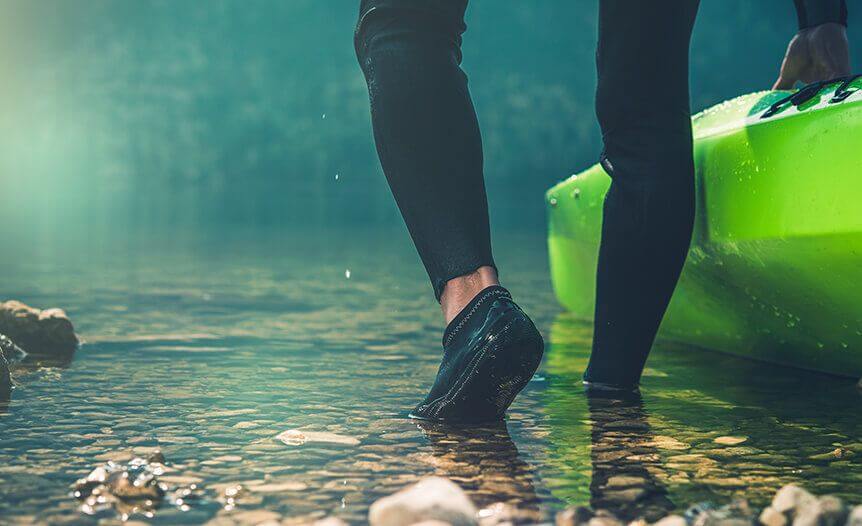Ultimate Guide to using Kayak Outriggers

The primary purpose of adding outriggers to your kayak is to increase your stability on the water. Most people new to kayaking are most concerned about flipping over. While kayaks are incredibly stable, unless over-loaded, they move from side to side easily, giving the appearance that they are unstable. Adding outriggers (also known as stabilizers) will provide additional stability to a point where a capsize event is near impossible.
If you've ever considered, do kayak outriggers and stabilizers work? Then you can keep on reading for all the information about these kayak accessories and find out. We'll cover all the basics about outriggers, including materials, where to install outriggers, and what advantages these units offer.
What exactly are kayak outriggers?
If you've searched for 'how to stop a kayak flipping?' and come across the term kayak outriggers, but you're not entirely sure what they are, then this section is for you. Kayak outriggers use two small pontoons attached to a standard kayak by a pole. Outriggers are commonly installed in the aft section of a kayak. These floats increase your stability on the water, making your kayak more difficult to capsize.
You can use outriggers when you're new to kayaking and are learning correct paddling techniques without the fear of tipping over. With the increased stability, outriggers make a better fishing platform and allow you to stand cast and reel in fish without any issues.
Keeping stable with kayak outriggers
Outriggers on a kayak will essentially turn your boat into a trip giving it three points of contact on the water instead of one. These contact points share the load and spread it over the water, so you now have three instead of one central balance point. Under everyday use, the kayak fitted with outriggers can be very hard to tip, even if you're trying! As with anything, there are exceptions, such as if you are faced with large waves (or the wake of a large boat).
If a kayak is tipped over with outriggers, it can be challenging to get it upright. Therefore, you should still wear a suitable lifejacket at all times. Practising self-rescue routines when kayaking is essential in all situations, and these will still need to be carried out even when you have outriggers installed.
Kayak outrigger types
There are two main types of kayak outriggers: hard-bodied polyethylene and inflatable.
High-Density Polyethylene (HDPE) outriggers
HPDE outriggers are solid and made of the same materials as many modern kayaks. These units are durable and may come with additional storage compartments, ideal for fishing or camping trips. As they are solid, they will need additional room in storage.
Inflatable outriggers
Inflatable outriggers are often made from tough outer material an inside bladder inflated when required. These can be easily inflated via a blowing tube, and they can be deflated quickly for easy storage. An inflatable outrigger can be damaged on rocks and submerged branches, but they're a good option if you're limited to storage space.
What to look for in kayak outriggers
If you've done your research and decided that outriggers are perfect for you, then you need to know the different types available and how to choose the right ones.
Materials
As discussed previously, you can choose between inflatable or HDPE outriggers. If you can't decide between these two options, you can try asking other kayakers about their experiences. In most situations, inflatables will be up to the job. However, if you're fishing, you may prefer the additional storage that comes with most HDPE outriggers.
In addition to the pontoons, you can also look at the side arms and what they're made from. The most common materials for these are aluminium, but you may also from fibreglass and plastic.
Price
Inflatables cost less than HDPE, but they are not as durable, meaning they may not last as long. However, if you have not tried outriggers before, then a set of inflatables are an excellent low-cost introduction. If you like the way your kayak moves with stabilizers, you can always upgrade to HDPE floats in the future.
Convenience
Check how adjustable the side arms are. Can you change the length? Do they provide enough clearance for your paddling style? Can you buy replacement parts? How easy are they to install and remove? A good set of outriggers will come with good support, and the sales team will offer advice on the best installation methods.
Installing a kayak outrigger kit
The exact method for installing an outrigger will depend on the ones you've purchased. However, most kits will use existing elements of your kayak, such as inbuilt rod holders. If you don't have rod holders to secure the outrigger shaft, you'll need to install appropriate holding devices.
The installation should be straightforward if you've purchased outriggers designed for your kayak. For all other kayaks, you'll need to find the right position where the pontoons are not interfering with your paddling style. The mounting kit provided may mean you need to drill into the deck of your kayak. It's best to follow all instructions provided (some manufacturers will offer video tutorials) and be prepared to call for support if you require any.
Using kayak outriggers when fishing
Kayak stabilizers and outriggers are most often used when fishing. When used in conjunction with a kayak anchor, you'll have a stable platform for lure and fly fishing. You can stand on the kayak and feel very secure that you will not tip over. One of the most challenging aspects for people new to kayak fishing is how much you'll move about in the water. By adding stabilizers, you will remove this movement, and you can focus on catching fish.
Kayak fishing is an exciting hobby, and you can use the outriggers with an electric outboard motor (installed on a nylon mounting block) and a rudder system to get you exactly where the fish are fast. Kayaking offers you a silent method for catching more fish, and it also allows you to access more areas. When you add in a set of outriggers, you won't need to worry about all your fishing gear going overboard, as tipping over is unlikely in normal use.
FAQ for kayak outriggers
About kayak outriggers
Can you put rod holders on an outrigger?
The floats may be out of reach for a rod holder. However, many kayakers place rod holders on the connecting poles. With the correct equipment is may be possible to attach other items such as a berley box to these poles.
Are kayak stabilizers worth it?
If you're new to kayaking and have concerns about falling overboard, or you are interested in a stable platform for fishing, then stabilizers are worth every cent. If you are looking for speed such as going down river rapids or doing time trials, then stabilizers may not be the ideal solution.
How can I make my kayak more stable?
Adding an outrigger kit is the best method for increasing your kayak stability. While using stabilizers, you can continue to work on your paddling technique, as this will also increase your stability.
How do I make my kayak hold more weight?
Unfortunately, outriggers cannot increase the amount of weight your kayak can support. If you want to take additional gear while fishing, it may be best to purchase a larger kayak.
How do you make an outrigger for a kayak?
As kayakers are an inventive group, you'll find it's possible to make your own outriggers. You'll need a pole and two floats to act as the pontoons. Attach the floats to your pole, and then attach the pole to your kayak. Getting your DIY outriggers working correctly may take time and several trials out on the water.
How do you stabilize a kayak?
Using an outrigger kit is the easiest way to add stability to your kayak. These devices will provide more balance, and you'll feel secure on the water.
How far out should kayak outrigger floats be?
The floats need to be far enough away that they do not interfere with your paddling stroke. Floats are usually between 75-100cm away from your kayak. The closer the floats are to your kayak, the less stability they'll provide.
Installing kayak outriggers
How do you attach outriggers to a kayak?
A good set of outriggers will come with complete instructions. At Kayaks2Fish, our outrigger kits are designed to be installed using the existing rod holders or the motor bar mounting position in the aft section.
Are heavier kayaks more stable?
Stability is determined more by the kayak's width rather than its weight. You'll find that lighter kayaks can carry more weight than heavier kayaks of the same size.
Can you add accessories to a kayak?
There are many accessories you can add to a kayak. Any accessories you add should provide positive value to your kayaking experience. A set of stabilizers will provide additional security if you're concerned about tipping over.
Can you stand in a kayak with outriggers?
Many fishing kayakers will use a set of outriggers for added stability. This allows them to stand and fish. You can also install an anchor kit to provide additional stability when standing and fishing.
Do kayak outriggers increase weight capacity?
No, kayak stabilizers do not increase weight capacity. Like any other accessor on your kayak, stabilizers will add to your overall weight on the water.
Where to buy the best kayak outriggers
At Kayaks2Fish, we have an excellent selection of HDPE and inflatable kayak outriggers. You can see if these are in stock in our online shop and order the best ones for your kayaks. In the HDPE floats, you have a choice of colours, and you can find the perfect ones to match your kayak.
If you need any assistance in choosing or installing your kit, you can phone our team, and we'll provide our expert advice. Outrigger kits are ideal for added stability, and you'll receive all the screws and other hardware to ensure it is installed securely and safely.










